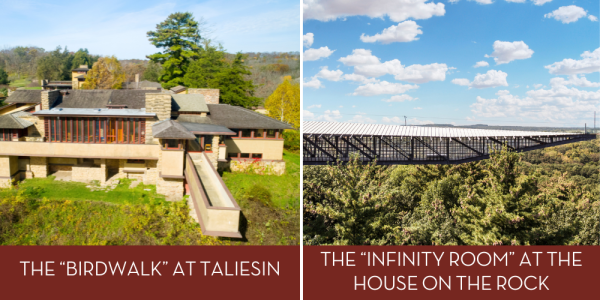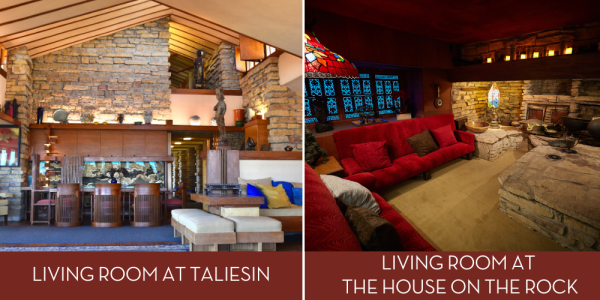Taliesin, Frank Lloyd Wright's House on the Brow of the Hill, and Alex Jordan’s Eclectic House on the Rock
Susan Kennedy, Communications Manager, Taliesin Preservation | Keiran Murphy, Frank Lloyd Wright Historian, Spring Green - July 29th, 2024
Two houses, less than seven miles apart, in rural Spring Green, Wisconsin
Taliesin and The House on the Rock welcome visitors from across the globe and are vital contributors to the local economy. Tour guests at Taliesin, particularly Wisconsinites, often ask their tour guides the following question, “Did Frank Lloyd Wright design The House on the Rock?” When they discover that he did not, and that it was built by a man named Alex Jordan, the second most commonly asked question is, “Did they know each other?” The answer to that question is, once again, “No, they did not.”
Sue Donaldson, owner of The House on the Rock, indicated that they also experience confusion, particularly in the Alex Jordan Center, where guests frequently ask, “When are you going to talk about Frank Lloyd Wright?”
Left: Frank Lloyd Wright sketching at Hillside Drafting Studio (1956) | Right: Alex Jordan building The House on the Rock (late 1940s or early 1950s)
The man who designed and built The House on the Rock was Wisconsin-native Alex Jordan, Jr. (1914-1989). Around the year 1940, Jordan discovered a 60-foot chimney of rock in rural Spring Green and decided to build a weekend retreat, using his knowledge of construction that he attained by working for his father. He worked tirelessly on the house for decades and built much of the original house himself, carrying materials up the steep rock cliff. In the end, however, he spent only four nights of his life there.
According to the book, Alex Jordan: Architect of His Own Dream, by Doug Moe, the House on the Rock is not, “a business, it’s not an ego trip. It’s a creative idea…. And Alex Jordan is the one who breathed life into it.”2Jordan began charging curious visitors 50 cents to tour the house, which paid for ongoing construction, the purchase of collections, and eventually the employment of sculptors.
While both Frank Lloyd Wright (1867-1959) and Jordan were Wisconsin natives, Jordan was neither an architect nor a Wright-apprentice in the Taliesin Fellowship. The confusion between these two people and places is understandable and likely stems from some of the following reasons:
Taliesin was built on the “brow” of a hill. Frank Lloyd Wright designed homes, including his own, in harmony with nature and coined the term, ‘organic architecture.’ Taliesin, which means “shining brow” in Welsh, is technically a House on the Brow of a Hill – and Jordan’s is a House on a Rock.
It is safe to say that Alex Jordan may have been influenced by Frank Lloyd Wright. According to former longtime manager of The House on the Rock, John Korb, Jordan used to study a Wright-designed house he grew up near, the Eugene Gilmore House in Madison. It was a house that Frank Lloyd Wright built in 1908.1
The House on the Rock is just down the road from Taliesin and both are in rural Spring Green, Wisconsin. A search on Google Maps shows how close the two houses are – and both are set along the same highway (Highway 23) south of Spring Green. With a driving distance of only 10 minutes between the two iconic destinations, it’s no wonder there’s confusion. Furthermore, The House on the Rock Resort is very close to Taliesin Preservation at the Frank Lloyd Wright Visitor Center, where all tours of Taliesin depart from (see map).
Map of rural Spring Green, Wisconsin, where only 6.7 miles separate Taliesin (north) and The House on the Rock (south). Wyoming Valley School is located in between, which is a school designed by Frank Lloyd Wright in 1956. Source: Google Maps (7/25/2024)
Taliesin tour guides and visitor services associates are sometimes asked before and during tours, “When will we see the carousel?” believing that Taliesin IS The House on the Rock – most likely because the chances are slim that these two iconic places could be so close to one another.
The House on the Rock’s Famous Carousel
The House on the Rock is one of the most highly visited tourist attractions in Wisconsin. It was made famous in part by having the largest indoor carousel in the world, which measures 80-feet-wide with 20,000 lights, 182 chandeliers, 269 animals, and not a single horse.
When author Neil Gaiman visited The House on the Rock in the 1990s, he said he walked out “baffled”3 and was so intrigued, inspired, and mesmerized by the place that he incorporated it into his book, American Gods(2001). It was later adapted into a series for Starz Network and Season 2 was filmed on location. The carousel plays a significant role as a meeting place for the gods.
The famous Carousel at The House on the Rock
A photograph of famed architect Frank Lloyd Wright is on the left. The image on the right is of The House on the Rock, not Taliesin (Baraboo News Republic, April 1996).
An example of a valid reason for the public’s confusion regarding the two places was in 1996 when area newspaper, the Baraboo News Republic (about an hour’s drive away), published an article that read, “Taliesin tour season opens,” announcing the upcoming tour season at Taliesin Preservation. However, the article shows a photo of Frank Lloyd Wright to the left and a photo of The House on the Rock on the right, instead of Taliesin (see image on right).
Taliesin’s Birdwalk and The House on the Rock’s Infinity Room
Anyone who has visited both places will notice a similarity between Taliesin’s Birdwalk and The House on the Rock’s Infinity Room.
Taliesin’s “Birdwalk” is one of Frank Lloyd Wright’s most playful additions to his home. One morning in 1951, he and his wife, Olgivanna, were enjoying the sounds of the birds from their living room when she said she’d like to “walk out amongst the birds.” This inspired Wright to use two 40-foot steel I-beams on his estate that had been left over from another project. He instructed his mason (George Haas) to construct a stone pier about 20 feet from the home. The I-beams were placed on the pier and the balcony was built on top of them.
Similar to the way that the Birdwalk at Taliesin juts out at a cantilevered angle, the Infinity Room was Jordan’s vision of a “long thin room” that would “hang in space.”4 It was added in 1985 and projects 218 feet out from the rest of the building. It is counter-balanced by 105 yards of concrete, making it possible for the last 140 feet to extend unsupported above the valley floor. The room has 3,264 windows and a triangular floor that angles up slightly to give the optical illusion that it travels to infinity.
The Living Room at Taliesin and The House on the Rock
The living rooms at Taliesin and at The House on the Rock have some similarities. They both use recessed, indirect backlighting, have stone walls, and stone hearths. Natural lighting is used at Taliesin and the living room at The House on the Rock has an evening feel.
More than anything else, one truth that cannot be denied is the fact that neither Frank Lloyd Wright nor Alex Jordan stopped working or changing their buildings throughout their lifetimes — and all of it took place within seven miles of each other in the beautiful valleys of the Driftless Region of Wisconsin.
Notes:
Historic image of Frank Lloyd Wright (1956): Courtesy of The Frank Lloyd Wright Foundation Archives (The Museum of Modern Art | Avery Architectural & Fine Arts Library, Columbia University, New York, NY). All Rights Reserved.
All photos of The House on the Rock courtesy of Sue Donaldson
Alex Jordan: Architect of His Own Dream by Doug Moe (House of Wyoming Valley, Inc., Spring Green, Wisconsin, 1991), p. 134.
“Architect of His Own Dream”, p. 13.
Neil Gaiman’s America: House on the Rock | American Gods – Season 2
“Architect of His Own Dream”, p. 120.






